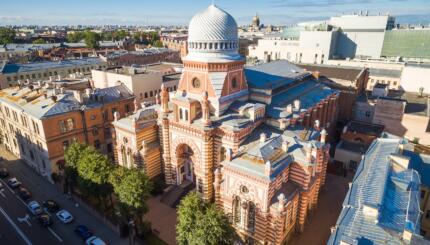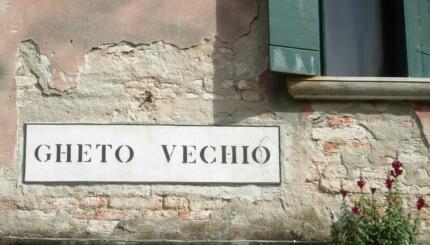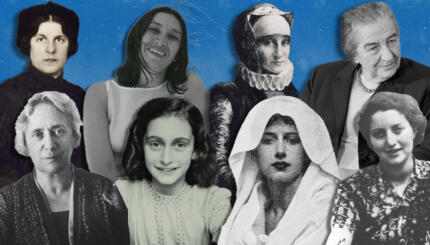The following article should be read in conjunction with the introduction to the theme of Jewish space, and the article on Jewish space in the life (1874-1952) of scientist and statesman, Chaim Weizmann. It is reprinted with permission from A Historical Atlas of the Jewish People edited by Eli Barnavi and published by Schocken Books.
Glueckel of Hameln, a contemporary of Louis XIV, would have liked, no doubt, to adopt, like Weizmann, the same radical solution to what would later be called the “Jewish question." She shared, at least, similar spatial experiences. A simple trader according to some, a proto‑capitalist according to others, she neither traveled the five continents nor crossed the seven seas. Nevertheless, she traveled far and wide. And when on rare occasions she stayed at home, spaces were clearly delineated for her (and for us through her descriptions). Her spatial experience, far more fragmented in certain respects than Weizmann’s, was organized in three distinct categories: economy, family, nation.
The seventeenth-century Jewish lady conducted matrimonial alliances for her family in a manner more reminiscent of the high nobility of the Ancien Regime than of Weizmann’s family. Her memoirs elaborate on the negotiations which preceded the signing of each marriage contract. Glueckel herself married at Hameln, one of her brothers married the daughter of a rich dignitary of the Prague community, one of her sisters was matched to a Jew from Emmerich, another to a Jew from Bonn, a son and a daughter in Berlin, another son almost married a daughter of one of the Oppenheimers of Vienna, but finally remained in Hamburg, a third son married in Copenhagen, a fourth in Bamberg, a fifth in Baiserdorf, a third daughter in Altona, and a fourth in Metz. And when Glueckel herself was ready for remarriage: “Matches with the most distinguished men in the whole of Germany had been broached to me.” Economic space and matrimonial space were thus, as we can see, congruent. Within the territory that was destined to become Germany, however, she did not cross a southern line which excluded Stuttgart, Nuremberg, and Munich. It seems as if she could operate only within Lutheran territory.
On the economic level, Glueckel knew one space only: northern and central Europe, "Ashkenaz" in her terminology. She and her husband Chaim regularly frequented the great fairs in Frankfurt‑on‑Main, Leipzig, and Brunswick. But their network extended as far north as Copenhagen, to the northeast as far as Danzig and Stettin ("We sent our son Nathan Segal, who was then about fifteen years old, to Stettin to see how things were, and began to send big parcels of silver. This was soon made up into coin and we were sent Stettiner dritteh, which we could sell immediately on the Bourse. There was a fine profit in this–about two in the hundred"), to the east, as far as Prague (‘We had lost 1500 reichstaler through a bankruptcy in Prague"), to the southeast, as far as Vienna, to the west as far as Amsterdam, and they even had plans for business in England.
But the notion of “space” is misleading, for it suggests a continuity that is absent in the picture evoked by Glueckel’s memoirs. What was “Home” to Gluckel? In order to answer this question, let us follow the family to Cleves, where the eldest daughter was to be married. They took a boat from Altona to Amsterdam, where they lodged with a Jewish associate and conducted business. After the ceremony, Glueckel went to pay her respects to her sister’s grave in Emmerich, and then the whole family began the voyage back. They spent fifteen days in Amsterdam, again on business. Arriving at Delftzil on the eve of Rosh Hashanah (the Jewish New Year), they stayed with a Jew from Hamburg. In Emden, they lodged with Chaim’s cousin. In Wangerooge, they spend Yom Kippur [Jewish Day of Atonement] with another of Chaim’s cousins. From there to Hanover, where Chaim’s parents lived; but there they were seized by anguish for there were no more relatives to visit nor business to conduct. Clearly, then, it was not a matter of proper “space,” but rather of scattered points here and there, and between these points were blank spaces in which there was nothing to do. In other words, Glueckel did not know Germany, nor did she actually “see” it. The only places that really existed for her where those where she could find business, relatives, or coreligionists.

Help us keep Jewish knowledge accessible to millions of people around the world.
Your donation to My Jewish Learning fuels endless journeys of Jewish discovery. With your help, My Jewish Learning can continue to provide nonstop opportunities for learning, connection and growth.
Three places, however, held special significance for Glueckel: Metz, Poland, and the Land of Israel. Each of these places was an “elsewhere” which defined her spaces–matrimonial, economic, cultural, or emotional. In Metz, she conducted negotiations for the marriage of one of her daughters, revealing even then a profound lack of cultural comprehension. When she herself remarried, she settled in Metz and spent the remaining years of her life there. The two last chapters of her Life, full of bitterness, convey a feeling of displacement: in Metz men wore wigs in a style imported form Paris; stranger still, the Jews there brought their commercial disputes before a non-Jewish tribunal! The French-German frontier was thus also the edge of her universe.
The same applied in the east. Glueckel’s space was defined by geopolitical conditions but her borders were also Judaized and flexible. With the Jews of Poland one concluded neither marriages nor business. Poland was a land of disaster: two of Glueckel’s brothers-in-law were ruined by the pogroms of 1648. But above all, it was a land of knowledge: more than once Glueckel mentions members of her family who either traveled to a in Poland or were instructed in Germany by a polish Jewish teacher. Yet the sages of Poland shared the norms of their country. One of Glueckel’s sons became a hostage of his Rabbi in Lissa (Leszno), and in his letter to his mother he writes: “It is Poland and if this befalls me, it will cost me ten times as much. So dear, beloved mother, do not forsake your child because of a little money and see that I am not delivered into their hands, for from them it will be hard to be freed.”
Let us summarize: while Glueckel’s “cartography” has all the apparent features of German cartography, it is in fact Jewish. On the other hand, at that time (paradoxically perhaps), only the Jews could really experience a “Germany.” Two centuries before Bismarck, Glueckel lived in a land united around the core of Prussia, a Germany where borders between principalities, duchies, and free cities, simply did not exist, as she was totally oblivious to them. As a Zionist leader was to say centuries later to Thomas Masaryk: “Among you there are either Czechs or Slovaks; only we, the Jews, are Czechoslovaks.”
For Gluckel, while Poland represented disaster and knowledge, Palestine was the incarnation of past and of hope. “’I should have forsaken the vanity of the world and with little left, gone to the Holy Land and loved there, a true daughter of Israel.” But she took no steps towards realizing this pious wish. In her memoirs, as in the mental universe of the Jews in general, the status of the Land of Israel was far from evident. By turning such pious wished into action, political Zionism, and before that militant messianism, interpreted this longing more literally than most Jews had intended.


